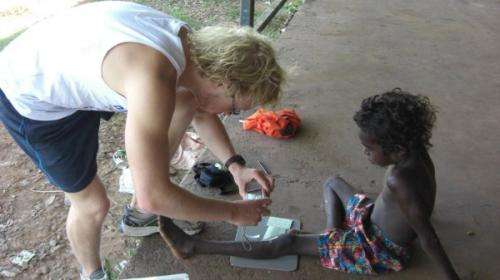Amateur photographers aid in remote skin sore trial

Paediatric infectious disease specialists are bringing novel skin sore research methods to WA in the form of a protocol allowing non-professional photographers to capture high-quality images of skin sores for use in treatment trials.
The global burden of the highly contagious infection impetigo (also known as skin sores) is estimated at 110 million children at any one time, with high rates in children in remote Indigenous communities.
Menzies School of Health Research PhD candidate and Telethon Kids Institute researcher Dr Asha Bowen says they were funded to conduct a randomised control trial to investigate better treatment options for impetigo in remote Indigenous communities in the Northern Territory.
"These communities are up to 1500km away from the research centre—when you're recruiting 660 kids over a three-year period it's difficult to take an expert to each community to assess each child's sore," Dr Bowen says.
Dr Bowen developed a simple image capturing protocol, including standardised lighting, camera settings, background, patient positioning and an in-frame sizing scale, to allow amateur photographers to collect data for subsequent expert assessment.
A quality control check by a medical photographer deemed 97 per cent of the unmodified images were adequate for interpretation while digital storing each image in triplicate resulted in just 0.17 per cent of images being unavailable for outcome assessment.
Oral antibiotic holds treatment potential
"Having a robust method for capturing the exact same lesion with the same parameters each time means that you can send a set of images to an external dermatologist for them to see how the lesion has progressed," Dr Bowen says.
As part of the study paediatricians familiar with treating impetigo compared pairs of de-identified pre- and post-treatment images of each sore and rated them on a scale of relatively healed-to-worse without knowing the order in which the images were taken.
The researchers also treated patients with either the oral antibiotic co-trimoxazole or the intramascular injection of benzathine penicillin G to assess treatment success.
"Before this study, only five percent of kids requiring treatment were being treated, which is probably related to the pain of the injection," Dr Bowen says.
"We demonstrated non-inferiority of the co-trimoxazole. This means that kids can now be treated with co-trimoxazole."
Dr Bowen will complete an early career fellowship at the Telethon Kids Institute and continue developing research methodologies to benefit Indigenous children in remote WA.
Dr Bowen says this method can also be used to help primary healthcare workers understand what sores requiring treatment look like.
















